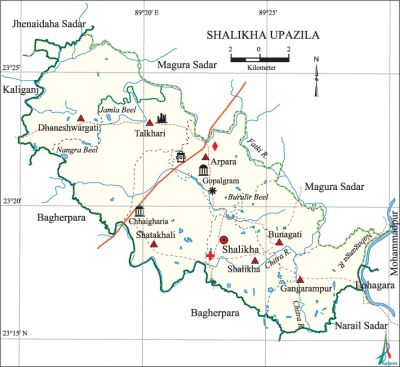Salikha Upazila
Salikha Upazila (magura district) area 228.65 sq km, located in between 23°15' and 23°27' north latitudes and in between 89°15' and 89°30' east longitudes. It is bounded by jhenaidah sadar and magura sadar upazilas on the north, bagherpara and narail sadar upazilas on the south, Narail Sadar, Magura Sadar, lohagara and mohammadpur (Magura) upazilas on the east, kaliganj (jhenaidaha) and Bagherpara upazilas on the west.
Population Total 163658; male 81536, female 82122; Muslim 119758, Hindu 43881 and Christian 19.
Water bodies Main rivers: Fatki, chitra, nabaganga; Jamla, Nangra and Burulir beels are notable.
Administration Salikha Thana was formed in 1924 and it was turned into an upazila in 1983.
| Upazila | ||||||||
| Municipality | Union | Mouza | Village | Population | Density (per sq km) | Literacy rate (%) | ||
| Urban | Rural | Urban | Rural | |||||
| - | 7 | 102 | 118 | 7155 | 156503 | 716 | 63.6 | 48.3 |
| Upazila Town | ||||||||
|
Area (sq km) |
Mouza |
Population |
Density (per sq km) |
Literacy rate (%) | ||||
| 5.13 | 3 | 7155 | 1395 | 63.6 | ||||
| Union | ||||
| Name of union and GO code | Area (acre) | Population | Literacy rate (%) | |
| Male | Female | |||
| Arpara 11 | 4620 | 12994 | 12798 | 54.4 |
| Gangarampur 47 | 7107 | 10652 | 10724 | 50.9 |
| Talkhari 83 | 11380 | 17433 | 17487 | 47.6 |
| Dhaneshwargati 35 | 10584 | 11441 | 11683 | 45.2 |
| Bunagati 23 | 5627 | 7843 | 7890 | 50.5 |
| Shalikha 59 | 5700 | 7274 | 7259 | 52.2 |
| Shatakhali 71 | 9685 | 13899 | 14281 | 45.1 |
Source Bangladesh Population Census 2011, Bangladesh Bureau of Statistics.

Archaeological heritage and relics Chhaigharia Mosque, Gopalgram Jami Mosque (seventeenth century), Loknath Asrama at Talkhari.
War of Liberation During the war of liberation the Pak army buried six freedom fighters alive after forcing them to dug their own graves at Shatakhali on the side of the Magura-Jessore highway. Seven freedom fighters lost their lives in the hands of the razakars at Talkhari. A memorial monument has been built in the upazila.
For details: see শালিখা উপজেলা, বাংলাদেশ মুক্তিযুদ্ধ জ্ঞানকোষ (Encyclopedia of Bangladesh War of Liberation), বাংলাদেশ এশিয়াটিক সোসাইটি, ঢাকা ২০২০, খণ্ড ৯।
Religious institutions Mosque 309, temple 16.
Literacy rate and educational institutions Average literacy 49.0%; male 51.8%, female 46.2%. Educational institutions: college 3, secondary school 27, primary school 49, satellite school 5, community school 5, madrasa 16. Noted educational institutions: Gangarampur PK Primary' Schol (1900), Simakhali Secondray School, Arpara Secondray School, Sharshuna Secondray School, Simakhali Primary School (1932), Arpara Primary School, Sharshuna Primary School, Bagdanga Shamsul Ulam Dakil Madrasa, Poripur Dakhil Madrasa, Shatakhali Darul Ulam Madrasa.
Cultural organisations Library 11, club 25, cinema hall 1, women organisation 1, theatre group 2, jatra party 2, playground 20.
Main sources of income Agriculture 78.76%, non-agricultural labourer 1.68%, industry 0.69%, commerce 9.08%, transport and communication 2.01%, service 4.48%, construction 0.69%, religious service 0.09%, rent and remittance 0.31% and others 2.21%.
Ownership of agricultural land Landowner 74.01%, landless 25.99%; agricultural landowner: urban 61.03% and rural 74.52%.'
Main crops Paddy, jute, pulse, oil seed, sugarcane, wheat, vegetables.
Extinct or nearly extinct crops Gram, sesame, kaun, arahar.
Main fruits Mango, jackfruit, banana, papaya, litchi, date, star apple, grape fruit.
Fisheries, dairies and poultries Fishery 2, poultry 4, cattle breeding sub-centre 2.
Communication facilities Pucca road 120 km, semi-pucca road 20 km, mud road 400 km; waterway 127 km.
Extinct or nearly extinct traditional transport Palanquin, horse carriage, bullock cart.
Noted manufactories Rice mill, oil mill, milk processing factory, welding factory, chocolate factory, ball pen industry, bakery.
Cottage industries Blacksmith, potteries, weaving.
Hats, bazars and fairs Hats and bazars are 28, fairs 10, most noted of which are Arpara Hat, Simakhali Hat, Chaturbaria Hat, Singra Hat, Bunagati Hat, Ganga Snana Mela, Baruni Mela, Durgapuja Mela, Kalipuja Mela, Shiva Gajan, Baishakhi Mela, Chaitra Sankranti Mela, bull fighting and Horse Race Mela.
Main exports Jute, paddy, wheat, pulse.
Access to electricity All the unions of the upazila are under rural electrification net-work. However 40.2% of the dwelling households have access to electricity.
Sources of drinking water Tube-well 97.8%, tap 0.3% and others 1.9%.
Sanitation 86.1% of dwelling households of the upazila use sanitary latrines and 11.8% of dwelling households use non-sanitary latrines; 2.1% of households do not have latrine facilities.
Health centres Upazila health complex 1, family planning centre 7, satellite clinic 2.
Natural disasters Many people were victims of the cyclones and tidal bore of 1585, 1909 and 1919, and the floods of 1938 and 1971, and famines of 1769-70 and 1943. These natural disasters also caused heavy damages to settlements, crops and other properties of the upazila.
NGO activities Operationally important NGOs are brac, asa. [Biren Mukherjee]
References Bangladesh Population Census 2001 and 2011, Bangladesh Bureau of Statistics; Cultural survey report of Salikha Upazila 2007.
